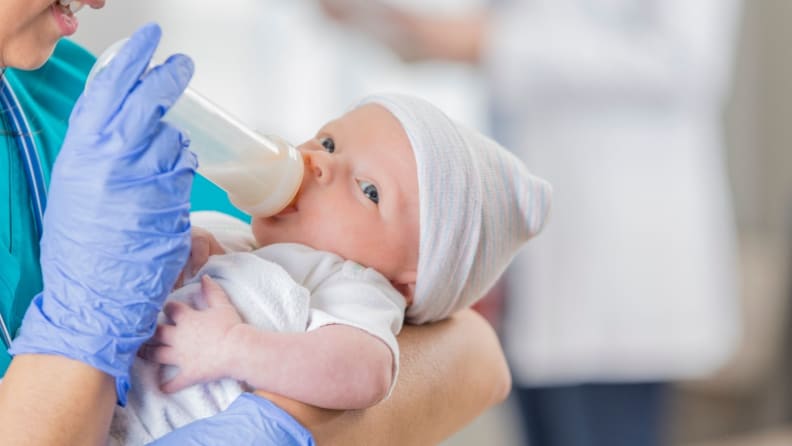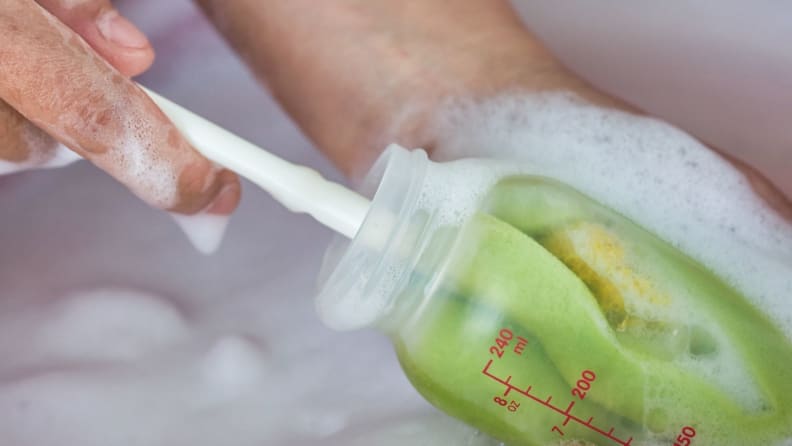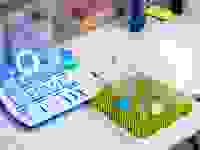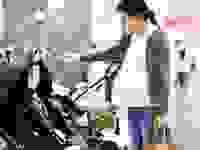 — Recommendations are independently chosen by Reviewed’s editors. Purchases you make through our links may earn us a commission.
— Recommendations are independently chosen by Reviewed’s editors. Purchases you make through our links may earn us a commission.With the current baby formula shortage, it's more necessary than ever to make sure that the formula you make is prepared correctly the first time around—and part of that means making sure your baby's bottles are clean and sterile.
According to Smita Malhotra, MD, FAAP, a Los Angeles-based pediatrician and the author of The Newborn Handbook: Your Guide to Bringing Home Baby, in most instances, a good scrub in hot water or a trip through your dishwasher should be all that you need to keep your baby’s bottle clean enough for use on a regular basis.
“If your baby is healthy and over three months of age, and you have clean water in your home, regular sterilization isn’t [something] you need to worry about,” says Malhotra. “Knowing how to sterilize properly is important and there are times where it’s absolutely necessary.”
Here, we break down the whens and whys of sterilizing baby bottles and the best methods for getting the job done:
When should you sterilize a baby bottle?

If your baby is sick, premature, or under three months of age, you should be sterilizing their bottles.
When we didn’t have continual access to clean municipal water, parents needed to sterilize their baby’s bottles after every use. Today you don’t need to put in nearly as much effort, but there are occasions when a thorough sanitization is recommended. Here is when you absolutely need to sterilize your baby’s feeding items.
If the bottle is new
It’s always advised to give new baby bottles a cursory sterilization before their first use. There’s no telling if other hands have touched the nipple, or if it fell on the floor. To be safe, give it a boil or a bleach clean to ensure it’s pristine.
If the bottle is second-hand or borrowed
It’s so great when you find a deal or you get to be the recipient of some excellent used baby gear from friends. In both of these situations, it’s crucial that you sanitize any of your baby’s feeding items to get rid of any lingering bacteria from previous owners, storage boxes or second-hand shelves.
Make sure that any old baby bottles you chose to use are BPA-free. In 2012, the Food and Drug Administration (FDA) banned the use of BPA in baby bottles intended for children under 12 months, due to concerns that it impacted child development. If you’re using older plastic bottles, make sure they don’t have the recycling number 7 imprinted on the bottom, which indicates that they contain BPA. If they have that number 7 on them no amount of sanitizing will make them safe for your child.
If your baby has been sick
“If a baby has been ill or has any sort of viral or fungal infection, you definitely need to sterilize at that point,” says Malhotra. If they have thrush, hand-foot-mouth, or any viral or bacterial infection, sterilization is a critical part of helping them recover.
If a baby is premature or has health issues

If your baby is premature or has health issues regular and frequent bottle sterilization may be necessary.
If this is the case your child’s doctor will likely advise you on sterilizing their bottles, but both Malhotra and the CDC caution that any child with any sort of weakened immune system should have their bottles regularly sterilized.
If you do not have access to clean drinking water
In most cases and in most countries, municipal drinking water is safe. However, if your drinking water is in question—or if you are traveling to an area where you are unsure if the drinking water is safe—you should take precautions and sterilize your child’s bottle after every use.
How often should you sterilize a baby bottle?

Freshly washed or sterilized baby items should always air dry on a clean towel. Never rub or pat dry.
Malhotra says that if you have a dishwasher with either a heat drying cycle or a sanitizing setting, it’s not necessary to take an added sanitizing step. “You really need to do what’s best for your family but, in general, if you have a dishwasher you can avoid the added stress of regular sterilization,” she says.
If you are hand washing, it’s still not necessary to sterilize too often, says Malhotra, adding that over-sterilizing can break down the bottle nipple if done too often.
How to sterilize a baby bottle
Before sanitizing, make sure you have thoroughly cleaned any of your child’s feeding items. Be sure to check with the item’s manufacturer about which method is safe for your child’s bottle.
Boiling in water
Don’t worry, plastic bottles and latex nipples are safe to sanitize using this easy method that's accessible for almost anyone. Here's how it's done:
- Fill a large pot with water.
- Disassemble all feeding items and place them in the pot, submerging and filling them with water to minimize floating. Be sure all of the pieces are completely covered with water.
- Put the pot over heat and bring to a boil.
- Boil the parts for about 5 minutes (be sure to check manufacturer recommendations).
- Remove parts with clean tongs.
- After sanitizing, place the parts on a clean, unused dish towel or paper towel in an area protected from dirt and dust. Allow each piece to air-dry thoroughly before storing. The CDC recommends that you do not use a dish towel to rub or pat items dry because doing so may transfer germs.
Bleach
Malhotra says that if you don’t have a dishwasher or boiling isn’t a choice, bleach is an alternative method and is particularly useful when traveling.
- Prepare a bleach solution of 2 teaspoons of unscented bleach per gallon (16 cups) of water in a clean washbasin.
- Submerge all items completely, checking that the solution touches all parts and there are no air bubbles in the bottles.
- Squeeze solution through nipple holes.
- Soak items in the solution for at least 2 minutes.
- Remove with clean hands or tongs. The CDC cautions against rinsing after sterilizing, adding that “germs could get back onto the sanitized items. Any remaining bleach will break down quickly as it dries and will not hurt your baby. This process is similar to what is done to sanitize dishes in restaurants.”
- Place items on a clean, unused dish towel or paper towel in an area protected from dirt and dust and allow to thoroughly air-dry before storing.
Steam cleaning
There is a lot of debate about microwaving bottles to steam sterilize and whether it is safe to do so. Malhotra says that if you are looking for a faster way to sanitize your child’s feeding items, a steam cleaner isn’t a necessity for your baby list, but it can save time.
“Boiling and bleach will absolutely do the trick, but [steam cleaners] do save time and I recommend them for parents who just don’t have the time to keep an eye on a boiling pot,” says Malhotra.
Each steam cleaner will be different, so it’s recommended to follow the manufacturer's instructions to the letter.
Get the Baby Brezza Bottle Sterilizer and Dryer at BuyBuyBaby for $100
In the dishwasher
If your bottles are dishwasher safe, then we have good news for you! Your appliance's hottest water setting and heat drying cycle is one of the best ways to clean bottles regularly and keep them sterilized. There are a few steps to follow:
- Separate all bottle parts completely.
- Rinse each part thoroughly with clean water and a scrub brush if needed to remove any milk particles.
- Put all bottle parts on the top rack of the dishwasher; smaller parts should go in a dishwasher-safe basket to ensure that nothing falls through to the bottom of your dishwasher during the wash cycle.
- Run the hot-water cycle for cleaning and "heat dry" for drying.
- Remove all bottle parts and let them dry on a clean dishcloth. Do not pat dry.
Get the OXO Dishwasher Basket at BuyBuyBaby for $10
And for a good scrub by hand...

Make sure that when you wash your bottles you use a brush and basin that are clean and only used for this purpose.
Before any sterilization, and in between, a good scrub in hot soapy water is critical. Here is how to get your baby’s bottles super clean every day of the week. After every cleaning, bottles should air dry on an area free of dust on a clean, dry towel.
The CDC specifies that it’s not only important to wash your baby’s feeding items thoroughly but to make sure that the basin you use and the bottle brush is sterile as well. To ensure this, be sure to use a bottle brush and a basin or bowl that are used exclusively for cleaning your baby’s bottles. They also recommend that you start with clean, washed hands.
- Take apart and separate all bottle parts including the nipples, caps, rings, and valves on each bottle.
- Rinse each item thoroughly to clear them of milk debris. Do not set them in the sink; instead, put them in the bowl or basin you have set aside for this purpose.
- Fill a basin with hot water and add soap.
- Scrub each item carefully using a clean brush that is used only to clean infant feeding items. Be sure to get to the very bottom of the bottle.
- Squeeze and flush water through nipple holes to clear them.
- Rinse completely, either by holding items under running water or by submerging them in clean water in a separate basin that is used exclusively for cleaning infant feeding items.
- Allow to air-dry.
Get the Boon Cacti Bottle Brush cleaning set at Target for $15
Related content
-

The Best Bottle Drying Racks of 2022best-right-now
-

The Best Baby Products for New Parents of 2022best-right-now
The product experts at Reviewed have all your shopping needs covered. Follow Reviewed on Facebook, Twitter, Instagram, TikTok, or Flipboard for the latest deals, product reviews, and more.
Prices were accurate at the time this article was published but may change over time.


